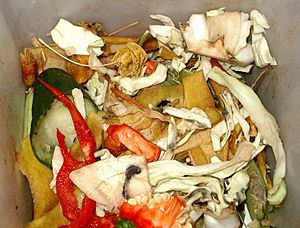Food waste facts for kids

Food waste means food that is thrown away. This happens either because people do not need it, or because rules say it must be thrown away. Different groups have slightly different ways of defining food waste. For example, the United States Environmental Protection Agency says food waste includes "uneaten food and food preparation wastes" from homes, shops, restaurants, and other places.
Food waste can be defined in different ways based on:
- What kinds of food are thrown away.
- How the food waste is created.
- Where the food is thrown away from.
Sometimes, food that is called "waste" might still be useful for other things. This can make the definitions a bit confusing.
How Food is Wasted on Farms
A lot of food can be wasted even before it leaves the farm. In places where people grow food just for themselves (called subsistence farming), not much food is wasted. This is because they grow food only when they need it. But in the modern world, farms grow food for many people all over the world.

Studies have looked at where food waste happens. In the United States, a lot of food is wasted right at the start of the process. After planting, crops can be damaged by pests or bad weather. This means some food is lost before it can even be picked. Things like temperature and rainfall are very important for how crops grow. So, farms that grow food outdoors can lose crops because of these natural events.
Machines used for harvesting can also cause waste. Sometimes, these machines cannot tell the difference between ripe and unripe crops. They might also only pick part of a crop, leaving the rest behind. Food is also wasted if it does not look perfect or meet certain rules for quality. These crops are often left in the field. They can then become fertilizer for the soil or food for animals.
How Food is Wasted During Processing
It is hard to know exactly how much food is wasted when it is being processed. This is when food is cleaned, cut, packaged, or turned into other products. When food is stored, a lot can be lost because of pests and tiny living things called microorganisms. This is a bigger problem in hot and humid countries, where these pests and microorganisms grow easily.
Very hot or humid conditions, or too many microorganisms, can also change how healthy food is. They can also change its calorie count and if it is safe to eat. It is harder to measure these "quality losses" than simply counting how much food is lost. More food is also wasted if it is not handled correctly, or if it loses weight or volume during storage.
It can be difficult to reduce some food waste from processing without making the food less safe or lower quality. Some rules about food safety cause food to be thrown away before it even gets to the shops. These safety rules are very important. They protect people's health, especially for foods that come from animals. Food from animals that is not safe can cause serious health problems. Keeping people safe is more important than preventing food waste or reusing food that does not meet safety rules.
Images for kids
See also
 In Spanish: Desperdicio alimenticio para niños
In Spanish: Desperdicio alimenticio para niños







